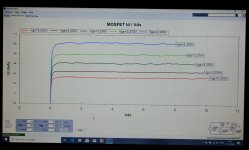I just got at little Peak measuring device. I was looking for something I could use for performing curve tracing without spending a lot of money. Just something simple. I ended up with this small device which has its limitation like only being able to measure at quite small currents (few mA). I think it is good enough for me and think I can learn a lot by using it. My hope is that I can match devices knowing that it will not be 100% perfect but probably better than random selection of devices.
The attached images shows a trace of a IRFP250.
Think it shows the "square law" relation between Vgs and Ids?
Just learned about that watching NP's lecture about Push Pull output stages. I must watch it again to get it all inside my head......lots of words…..
Think I understand why M2/M2X does not need matched output devices……
I was surprised of the quality of the Peak. The clips etc. are much better than usually cheap "junk". I also purchased a SOT23 probe so measurements of these small devices can be performed quite easy.
I was tool lazy building test rigs with 9V battery etc...….
The attached images shows a trace of a IRFP250.
Think it shows the "square law" relation between Vgs and Ids?
Just learned about that watching NP's lecture about Push Pull output stages. I must watch it again to get it all inside my head......lots of words…..
Think I understand why M2/M2X does not need matched output devices……
I was surprised of the quality of the Peak. The clips etc. are much better than usually cheap "junk". I also purchased a SOT23 probe so measurements of these small devices can be performed quite easy.
I was tool lazy building test rigs with 9V battery etc...….
Attachments
to MEPER
Hello MEPER,
I use the PEAK ATLAS DCA75 PRO for a few months.
It is a very good tool to measure active devices and to match them. And for much more...
Well worth every cent! 😀
I bought it circa 1 year ago for 102,30 € in Germany.
Greets
Dirk
Hello MEPER,
I use the PEAK ATLAS DCA75 PRO for a few months.
It is a very good tool to measure active devices and to match them. And for much more...
Well worth every cent! 😀
I bought it circa 1 year ago for 102,30 € in Germany.
Greets
Dirk
I got it directly from the "factory" in UK:
Peak Atlas DCA Pro model DCA75 | Peak Electronic Design Limited
A bit higher price…..which is Ok.....I am happy for the SOT23 probe. It is nice to be able to match even if it is not strictly necessary.
Wonder if I should have got the kit which includes the LCR45......easy to be a bit "greedy"......
Peak Atlas DCA Pro model DCA75 | Peak Electronic Design Limited
A bit higher price…..which is Ok.....I am happy for the SOT23 probe. It is nice to be able to match even if it is not strictly necessary.
Wonder if I should have got the kit which includes the LCR45......easy to be a bit "greedy"......
I don't have the SOT-23 probe. Have to look for that.
I think makes life (measurements of the SMD devices) much easier.
Thanks for the hint!
Good night - need some sleep
Dirk
I think makes life (measurements of the SMD devices) much easier.
Thanks for the hint!
Good night - need some sleep
Dirk
Michael Rothacher has an article about how to build a curve tracer for outr SIT devices I assume it would work with other devices as well but am not shure. Frankentracer: $20 SIT Curve Tracer Part One | AudioMaker
It is nice for measuring power FETs at high currents and gives nice smooth curves. Something to consider. There are some DIY curve tracers out there which uses the X-Y input of an analog scope.
A nice thing about the Peak is that you can connect the device random to the clips and that you can put all the measuring values into an Excel (it can be pasted into it). But for high currents you need the DIY device. I have a scope with X-Y input and also a variac and also a dedicated box…..so something to do in the future. With 1-2 Amps the heatsinking of the DOT should not be forgotten…….
A nice thing about the Peak is that you can connect the device random to the clips and that you can put all the measuring values into an Excel (it can be pasted into it). But for high currents you need the DIY device. I have a scope with X-Y input and also a variac and also a dedicated box…..so something to do in the future. With 1-2 Amps the heatsinking of the DOT should not be forgotten…….


